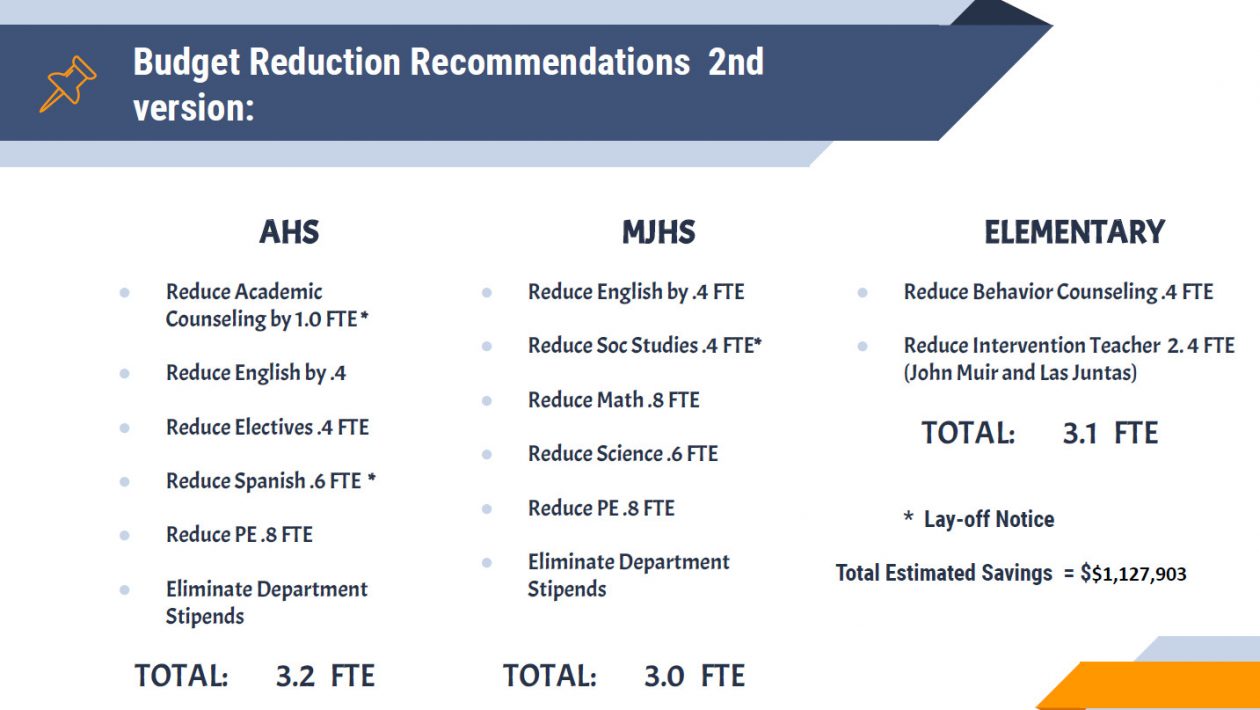Martinez Unified School District Board of Education began its first round Monday to trim nearly $1.5 million from its 2020-2021 budget by laying off three part-time certificated employees.
A social studies teacher, a Spanish teacher and an academic counselor will be given termination notices May 15, the panel decided unanimously.
The panel also received an information report that recommended cutting two typist clerks, a student body account clerk and a library media assistant later this month.
District Superintendent C.J. Cammack said the cuts were the latest in a series he blamed on state underfunding of schools, unfunded state pension costs and inadequately-funded but mandated state and federal special education that force the District to pay 65 percent of the costs out of the General Fund.
In Fiscal Year 2016-17, the District cut $1 million by eliminating an administrative position and one teacher’s position, reducing a supervisor position and deciding not to fill three fulltime equivalent (FTE) positions. Services and contracts were decreased.
The cuts continued last year with the elimination of one teaching position, four paraeducators, reducing the chief technology officer, maintenance and operations coordinator and several clerical positions.
The District must eliminate about $1.5 million from its 2020-2021 budget to keep its required level of financial reserves intact and remain solvent, Cammack said.
The District is reducing library media assistant hours by 50 percent at elementary schools, keeping those libraries open two days a week, and by 25 percent at Martinez Junior High School and Alhambra High School, keeping those libraries open daily.
Martinez Education Association President Brenda Leal worried how the cutbacks and limited access would affect reading programs in elementary grades. Speaking several times Monday, she urged the District and residents to write state and federal elected representatives and ask for more school funding.
“We worked hard to keep the cuts away from the classroom,” Area Three Boardmember Deidre Siguenza said. “This is really heartbreaking.”
But the District’s financial situation could get worse, Cammack said in another report to the Board – this time on impacts from the COVID-19 virus pandemic.
The District based its $1.5 million cutbacks on the state’s budget projections released in January, he said. But the School Services of California wrote May 7 that the Department of Finance is expecting state revenue losses of $9.7 billion in the current year, another $32.2 billion loss in the coming budget year.
State social services costs are rising, and may bring the total shortfall to $54 billion going into Fiscal Year 2020-21, School Services of California said in its article. The new estimated loss of education funding would be the equivalent of a negative 22 percent cost of living adjustment.
“On a per average daily attendance (ADA) basis for the Local Control Funding Formula (LCFF), the average reduction is approximately $2,300 in 2020-21. Total per-ADA revenues, inclusive of the LCFF, would be down by $2,600-$2,700.”
Those are early projections, Cammack explained, so actual impacts are not yet known. Governor Gavin Newsom is expected to revise his proposed budget numbers within a few days, and Cammack doesn’t expect the news to be favorable.
The District began in April surveying all staff members to obtain their concerns, questions and ideas, and it has formed a task force with members from its teacher and support personnel unions and administrators. A similar questionnaire is being written, to be sent to parents.
The task force, meeting May 12, 15 and 19, will develop concepts but not policies, because any proposal would be subject to union negotiations. But those concepts may help the Board with its finance discussions.
The pandemic and the state and Bay Area shelter-in-place orders have affected the District in other ways. Cammack stressed that Martinez Unified’s schools aren’t closed – they’re prociding “distance learning,” or teaching through remote services.
The District has distributed 940 electronic devices to students and has 20 hot spot devices are giving some families internet access for the first time. Eight student device deployment sessions have helped parents who have picked up those devices.
Teachers and District support staff have translated conventional “face to face” lessons into a virtual format, Cammack reported. Counselors are helping both students and staff members, and special education and para educators are helping the District meet its obligations.
Martinez children – even those who are assigned to schools outside MUSD have received 11,058 pick up meals, he said.
The pandemic will impact summer school, but the District is using systems it has employed in the past, especially to help special education students. Those students may be taught through “distance learning” even after classes return to campuses, because maintaining required distances would be a hardship in their classes, Cammack said.
In other matters Educational Services Director Amy Black recommended the Board approve reducing required graduation credits to 220 rather than 240. Most neighboring districts also require 220 credits for graduation, and both numbers are well past the state requirement of 130 credits.
The proposal includes another recommendation, that approved seniors might take four courses rather than five. That would give those students more flexibility to seek work, obtain internships or apprenticeships or take classes at Diablo Valley College. The matter will be considered at a future meeting.
(Replay of MUSD meeting)






Whatever happened to all the Lottery money that’s supposed to go directly to the schools??? The lottery is still going great guns.